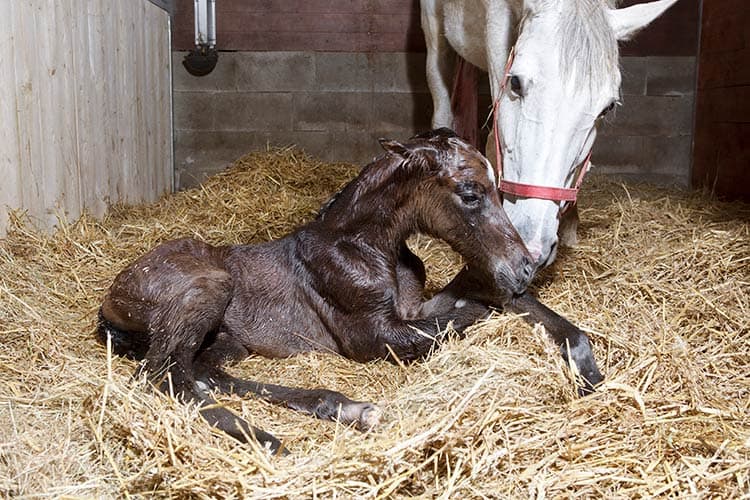Identifying and Managing High-Risk Pregnancies in Horses

Certain causes of abortion, such as umbilical torsions and congenital deformities, are unavoidable. However, many other causes, particularly those related to placentitis and infectious disease, can be prevented with timely detection and meticulous management. In this article our sources will describe the process of identifying, monitoring, and properly addressing high-risk pregnancies to maximize the foal survival rates.
Monitoring High-Risk Mares
“We consider ‘high-risk’ a mare that has previously aborted or had placentitis, a systemic disease, or either colic or reproductive surgery,” says Karen Wolfsdorf, DVM, Dipl. ACT, a theriogenologist at Hagyard Equine Medical Institute, also in Lexington. Studies also put mares with a history of vulvar discharge, premature udder development, and premature lactation in that category (Lanci et al., 2022).
Much like high-risk human pregnancies, equine gestations flagged . In theriogenology, the ultrasound probe serves as the practitioner’s eyes and ears, allowing them, first and foremost, to detect fetal heartbeat and viability. “Fetal heart rate decreases when the fetus is metabolically stressed,” says Alana King, DVM, Dipl. ACT, a theriogenologist at Millbrook Equine Veterinary Clinic, in New York. “A low heart rate is particularly evident when blood oxygen is low due to a compromised placenta.”
This brings us to our second use of ultrasonography in theriogenology: evaluating the health of the uteroplacental unit. “We can use ultrasound to diagnose abnormalities early so the appropriate therapy can be initiated while time is still on our side,” explains Wolfsdorf. “Transrectal ultrasound examinations starting at six to seven months of gestation allow us to notice important changes such as:
- Placental or uterine edema.
- Thickening of the combined uterus and placenta (CTUP), which is associated with placentitis (Kimura et al., 2018).
- Separation of the placenta from the endometrium (uterine lining).
- Abnormal fetal fluids.
- Opening of the cervix, a potential indicator of ascending placentitis.
- Ischemic necrosis (cell death caused by oxygen deprivation) of the placenta.
- Placental hydrops, or excessive fluid in the placenta.
- Placental separation with exudate, which is indicative of .”
Getting Answers Through Serology
Aside from diagnostic imaging, equine veterinarians rely on bloodwork to identify potential problems in utero. “Hormone panels that evaluate progestogens and estrogens—two of the main pregnancy hormones—can be useful in determining the health of the fetoplacental unit,” says King. “Progestogen levels that are too high or too low can indicate a problem with the placenta. Total estrogens are associated with fetal viability and treatment outcomes, with lower levels indicating a poorer prognosis.” She explains that monitoring trends of these hormones over a period of weeks can help veterinarians determine whether treatment is working.
“If we want to get more specific, changes in serum progestins, estradiol 17B, alpha fetoprotein, and inflammatory markers have been linked to placentitis and other high-risk pregnancies,” says Wolfsdorf, justifying the need for strategic blood testing of pregnant mares. While these tests are not yet commercially available, they are currently being studied, she says.
Specifically, Lanci et al. (2022) explored the value of alpha-fetoprotein (AFP) concentrations in the amniotic fluid and foal plasma in predicting abnormal pregnancies and sick neonates. Alpha-fetoprotein is a protein that develops in the fetal liver. Increased plasma levels of this protein have been found to be associated with sepsis, prematurity/dysmaturity, and hypoxic-ischemic encephalopathy (oxygen deprivation to the brain) at birth, as well as with histopathological lesions of the chorioallantois (fetal membrane). “AFP is increased in plasma of foals born from high-risk pregnancies,” the authors concluded.
Giving High-Risk Mares the Best Chance of Success
Once veterinarians have identified a high-risk pregnancy, either through medical history, ultrasonography, bloodwork, or a combination thereof, they can take several steps to maximize the mare’s chance of delivering a live, healthy foal.
First, the mare’s owner must decide whether to manage the pregnancy on the farm or board the horse at a clinic. Wolfsdorf says this decision depends on the stage and severity of the disease in question.
“As a general rule, the preference is for high-risk mares to foal in a hospital or specialized foaling facility, when possible,” says King. “Foals from high-risk pregnancies are more likely to be born prematurely, have , or have sepsis and may be weak or unable to nurse. These foals generally require immediate intensive care to maximize their chances of survival. Ideally, mares would be transported to these facilities as soon as they are identified as high-risk. If this is not possible, they should be transported when milk electrolytes and pH indicate that they are close to foaling,” adding that mares with placentitis might not have reliable milk electrolytes or pH levels.
“In some cases, high-risk pregnant mares may be managed on the farm,” King says. “We recommend having a foaling kit ready with a pair of sharp scissors in case of red bag delivery, a set of chains or straps, and a foal resuscitator or bag valve mask (Ambu bag). Your truck and trailer should be hooked up and ready to transport the mare to the clinic quickly if necessary.”
Many high-risk mares will also leak colostrum (antibody-rich first milk) in the days leading up to foaling, resulting in a lack of quality colostrum when the foal arrives. King recommends having banked colostrum on hand is when managing a high-risk mare on the farm.
The Role of Medicine
Whether the mare is at home or at the hospital, her owner should establish a specific treatment plan with their veterinarian. “Treatment protocols for placentitis—one of the top causes of pregnancy loss—should address the numerous aspects of the disease process,” says Wolfsdorf. “Start with appropriate antibiotic therapy, determined by culture and sensitivity if copious vaginal discharge is present. The most common bacteria associated with ascending placentitis are Streptococcus zooepidemicus and E. coli. Therefore, a broad-spectrum systemic antibiotic that crosses the placenta is warranted. Anti-inflammatories such as firocoxib or flunixin (meglumine) aid in controlling the inflammatory process and mitigating uterine contractions.”
“Furthermore, supplemental progesterone will also aid in uterine quiescence (active relaxation of the myometrial smooth muscle cells, responsible for maintaining pregnancy) and tightening the cervix,” she continues. A closed cervix during pregnancy is essential in keeping the fetus and placenta safe from ascending debris such as feces, urine, and airborne pathogens. “And finally, improving vascular perfusion (blood flow) to the uterus with an anti-inflammatory component by using acetylsalicylic acid or pentoxifylline can also help the developing fetus.”
Final Thoughts
Foals born from high-risk pregnancies are often small, dysmature, and potentially septic, says Wolfsdorf. But a less-than-ideal birth doesn’t automatically condemn the horse for the rest of his life.
“In fact, a study that looked at the racing potential of 190 foals born (from mares) with suspected placentitis that survived verses 190 ‘nonplacentitis’ foals found no difference in performance (Hughes et al., 2014),” she says. “Placentitis is not usually a systemic disease; therefore, once the mare has foaled and her uterus has been treated appropriately, her future fertility should not be affected.”

Written by:
Lucile Vigouroux
Related Articles
Stay on top of the most recent Horse Health news with















